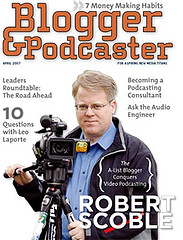
Part Three of a series discussing blogger relations, “Building a Bridge Between Your Story, Bloggers, and People.”
Now that blogging is crossing over into the mainstream, certain bloggers have earned a right of influence and clout that rival many of the top journalists.
Good friend Robert Scoble recently discussed the subject of blogger relations, embargoes and the process of news and launches in tech PR. Scoble, for those who may or may not know, is probably the one of the world’s most recognized bloggers. While his forte lies in tech, his influence if far greater. For Scoble to take the time to observe trends in PR and openly discuss them in the blogosphere is representative of an important shift in news distribution and the art of influence.
It got me thinking.

The business of news distribution, from a “smart” PR perspective is evolving out of necessity with new processes dictated by the more savvy practitioners. But in some cases, it’s important to expose the mechanics of the new media machine for the betterment of the entire industry.
I don’t know about you, but I’m a little burnt on just being a “PR guy.” There’s so much more to what we do, so why not work on the PR for the PR and actually improve things.
Introducing news used to be pretty cut and dry. We’d start by running a press tour a couple of months in advance to the brief monthly print publications and analysts. Then as the official launch day would approach, we’d hit weekly print two weeks out and then online a few days prior – holding everyone to the same embargo date. The press release would then cross a news wire and some would support it with media outreach while others would cross their fingers and hope for the best.
This entire cycle seems like a luxury nowadays as the cycle of innovation is completely dependent on frequency in order to compete, and that frequency has radically shortned the span between communicating news. In turn, the business of news targeting and distribution is favoring short lead outlets such as newspapers, weeklies, as well as online venues.
Enter blogs.
Bloggers have changed everything and it’s sending PR people into a frenzy for how to launch products and broadcast news.
Yes, we’re talking about tech and maybe that’s not the industry you’re in. However, in tech, things work on a bit of a more hectic, hurried, and constant schedule, but the processes that we develop and evolve, wind up inspiring other industries. Basically this is edgework. We’re defining and refining new processes and strategies and bringing them back to the center.
So when tech bloggers emerged as part of the mix, we found ourselves rethinking (maybe scrambling in some cases) to figure out how to balance bloggers without upsetting relationships across the board.
Scoble states, “I’ve noticed that PR types are getting very astute with dealing with bloggers lately…First they’ll call Mike Arrington of TechCrunch. Make sure he’s briefed first (Mike doesn’t like to talk about news that someone else broke first, so they’ll make sure he is always in the first group to get to share something with you all). Then they’ll brief “second-tier” bloggers like me, Om Malik [of GigaOM], Dan Farber [of ZDNet], Read/Write Web, and a variety of others. Embargo us all so we can’t publish before Mike does.”
He’s partially right. There is a process, but trust me, it’s a process rooted in respect, admiration, and cultivating relationships (at least for the more effective communicators anyway.)
I’ve dubbed bloggers the new “wire” service. Providing them with early access to information allows news to bubble up, gaining credibility and momentum to the point where it attracts attention from traditional journalists. Bloggers have direct relations with people, your peers, and they thrive off of their participation.

Attention wire representatives, I’m not saying that bloggers have replaced you. Wire services are still valuable in not only sharing financial information and meeting disclosure requirements, they also have integrated with search engines allowing press releases to reach people directly.
Bloggers add a new step at the beginning of the process.
For example, one of the primary reasons that we launch most tech companies and products in “Beta” these days is because we want feedback directly from the people who would jump in early and give honest feedback as well as sharing the information with their friends and associates. And, if a product is in Beta, most traditional media wouldn’t yet pay attention. However, those journalists who do feel a greater sense of competition with bloggers in order to be one of the first to share new, new information, will make it known through their coverage.
This is why it’s so important to listen and read before you create any marketing strategy.
Working in Beta not only adds a new step to the communications process, it also affects product marketing as it also requires the team to factor in time and energy for a private or public focus group in order to build awareness and garner feedback.
Most traditional journalists these days want to hear about things that are either ground breaking or changing things in a way that is demonstrable by the massive support of the people who use it. After the beta gains momentum, and enough people use it favorably, then traditional media comes into play.
The next step after that is hitting the “magic middle,” bloggers who are defined as having a range of between 20 – 1,000 inbound links to their blog. These are the influencers who truly move the needle for customers and is among the best peer to peer marketing avenues you can pursue. In many cases, these bloggers are you prospective customers.
How do you share news with bloggers? Well, a lot of it has to do with relationships and for that, I suggest you read the series on blogger relations (Part I and II.) I can tell you that it’s different for different industries and there isn’t an exact science yet.
Certain bloggers maintain a higher authority than others, and while it fluctuates, most levels of influence remain constant over time.
The business of news has advanced quite a bit in the tech world, and by advanced, I mean that it has introduced a new layer to the equation.
Let me first clarify, there is still a thriving news business
within traditional media. In the tech world however, the art of Beta news is the new game. But, this is not unlike other industries. Early information, prototypes, leaks, R&D;, are all things that give bloggers their edge these days and, if executed properly, they only escalate the brand and the anticipation for new things among traditional press and ultimately customers.

But going to bloggers is tricky. Favoring one and not the other can cost you credibility and relationships. So borrowing a page from the traditional PR playbook, bloggers have embraced embargoes to maintain the privilege of receiving early information – in most cases.
I can tell you most certainly that I’ve had several instances where bloggers broke embargoes, which could have been costly if we didn’t have backup plans in place. I have witnessed the wrath that can result if one blogger goes before everyone else. It all comes down to relationships, having valuable news to share, and working with a select group of people that can really help build the community, while adapting to the way they work.
But this is the wild west. Live and learn.
Exclusives come into play these days still, however, they’re growing more rare. Offering one story to one writer may most of the time, limit the total visibility for any story, as most bloggers extend the reach to a more complete global community of people.
Scoble points to organic initiatives such as those executed by Kyte.tv and Seesmic. Both companies are embracing bloggers, and influential players directly, without PR, to introduce them to the product and let them experience it without influence. He openly wonders if these techniques may be more beneficial in the long run instead of playing the news game.
Well, to tell you the truth, you can still run both and be successful – as long as you’re smart and genuine about everything.

Working one on one with important people, whether they’re bloggers or enthusiasts, will only benefit you in the short and long term. However, this isn’t always a guaranteed success – even though anything rarely is these days.
Remember this…campaigns aren’t viral. People make them viral.
If it’s anything that Social Media has taught us is that we can empower people to help carry the word out to others. However, most executives are far too impatient to sit and wait for an organic campaign to get traction.
Now, an even earlier step can be introduced into the process as a way of gaining traction sooner. Before Beta, there’s Alpha and this is usually an experiment in organic marketing, driven by a sense of scarcity and exclusivity. Note, many companies also dub this “Private Beta.”
Most of the time, new companies and services are previewed in private, through either invitations, opt-in reviews, or password-protected links. Bloggers, media, and enthusiasts are all included in this round and empowered to share information with other peers to build up excitement. For example, microblogging service Pownce was almost an overnight sensation as it was introduced in private to a select group of influential geeks and bloggers. Their touting of access to the site combined with the fact that each were also empowered with a set of invitation codes, created a hyper-active market for invitation exchanges, with some actually going on ebay (and selling!).

As mentioned earlier, Loic LeMeur’s Seesmic is pursuing the invitation strategy and is currently in Public Alpha. This is unique in the sense that it still creates a sense of exclusivity, however, people are so excited to be part of it, that they show off their creations in public, thus fueling demand and increasing visibility for the up-and-coming company. Here’s an example of Robert Scoble using Seesmic to discuss Upcoming.org, which he promoted across all of his social networks.
Imagine for a moment breaking news organically without worrying about embargoes, but instead by using social tools and people through all channels of Social Media to share information before an official launch. Yes, it’s possible and is being practiced and streamlined now. But, we can talk more about that later as part of an upcoming series, “How to do PR without a Press Release.”
Social media is forcing an evolution in how companies share information with customers as well as those who also act as information intermediaries to the people that depend on them for guidance. The art of news is truly an art and it requires practice and experience. It also requires talent and creativity. The most successful ways of sharing news will be dependent on your ability to listen and by building and cultivating relationships with those who can help break news under the “new” rules of the launch.
There isn’t one way to work with bloggers, enthusiasts, and traditional journalists, but there are more than enough opportunities to do it the wrong way. Pay attention. Think. Be Creative. Have a plan. Build trust and ensure that your intent is genuine.
Conversations with the bloggers and media (and customers) will help dictate the launch and news strategies that are going to have the biggest impact and meaningful benefits for your company.
Read the full article with a white background.
Related Articles:
Building a Bridge Between Your Story, Bloggers, and People Part I
Building a Bridge Between Your Story, Bloggers, and People Part II
Robert Scoble Asks, “Is Facebook the New Press Release?”





We do much more than PR in the classic sense of media relations, yet few folks really understand what PR is…
Brian, this post is outstanding and should be mandatory reading for anyone who is in our business. Lot’s of cookies and though leadership. Great job, and thank you for sharing this info.
An excellent post again Brian. This 101 series on blogger relations really gets to grips with how the world is changing and how we must adapt to work within it.
With all of the reelases I get, I find the ones who treat me like a human, get the highest readability factor. Spell my name correctly, do some research on who I am, etc.
I also think many bloggers need some hand holding and sending only a release can produce an undesired result. The key is to give points and some info that gives the blogger a sense of distinction from the other bloggers.
Brian,
I’m a relatively new reader of your blog and I think you’ve got some great insights. Couple of notes: this post is too long. I read it in my Google Reader and start skipping if it is too long. When I went to your blog, I noticed that you’ve got a black background with white text. You’re much better off with a light background and dark text for readability. Hope you see this for what it is, positive comment to improve a really interesting blog.Cheers,
David
Geoff, thank you so much. I really appreciate the feedback and support.
Jonny, thanks for stopping by. Hope it helps.
Allen, you rule!
David, you’re absolutely right. Once I get going, I can’t seem to slow down!
Here’s a link to the post in ThinkFree with a white background:
http://thinkfreedocs.com/docs/view.php?dsn=837914
What makes you think Scoble isn’t in PR? 😉
While the post is enlightening and informative, I cannot agree with Scoble’s take that, “the cycle of innovation is completely dependent on frequency in order to compete, and that frequency has radically shortned the span between communicating news.” The message is still the most important component of any communication cycle, Sender – Channel – Message – Receiver. Same as it ever was. The channel is simply that, the channel, whether it is a blog, phone call, fax or the Good Year Blimp. Frequency is important for maximizing the utility of the blog channel, but the importance and news worthiness of the message will ultimately determine its success in the mass media. I don’t care how many times you post in a blog about Maria Osmand passing out on “Dancing with the Stars,” the importance of the message is still very limited.
Don’t get me wrong, I think you must consider using blogs in overall communcation strategy, but only as one component of media relations planning. Let’s not overestimate the importance of blogs as a distributon channel. It’s just the latest in a long line of tools for PR professionals to leverage on behalf of their client, organzation or product.
Regards from the Beach Chair,
Matt Gentile (FloridaMoves.com – 300 Days of Sunshine)
Correction, Solis’ take.
What allen said 🙂
An invite to a party also works extremely well.
The power of offline networking will always trounce online virtual glad handing. It took a Blog Tour to realize this.
A nice read Brian.
I come here not to have my turned around 180 degrees, but to re-orient me on my “work mission”; it’s so great to see a purist perspective on organic story development.
I really think a lot of this comes down to storyline. These are days of SEO-driven press releases, where companies issue phony announcements in order to game search engines and two things can combat this:
1. real stories
2. genuine engagement
You said it, man.
As the community evangelist at Microsoft, Robert was acting in a PR role.
Now, it’s clear he’s media.
could you tell the difference between online marketing and online PR?
Brain,
You mentioned http://www.kyte.tv as an expample embracing bloggers. kyte is sill in beta stadium and new features are added and tested often. There is no time to go through all media for every update. But the bloggers are fast enough to try out and comment new features. So blogs are a great source and independent!
Kyte lauched a new design recently. It showed up in many blogs soon; the same was with the kyte application for facebook. For bloggers all this features are good news, but the readers of magazines and newspapers probably are only interessted in major releases and innovations.
Keep doing your good work.
Greetings. Claudio.
This is a great article, especially for people like me who are just starting to blog. As a newbie, I find the pace of the Internet overwhelming. I don’t think I’ll ever replace anyone on the wires. Needless to say, I think there’s a place for people like me. Perhaps bloggers should be judged not on how fast they contribute something, but on the content of what they contribute.
I totally agree that a change is needed to continue to work with blogs. But if people really want to do some PR – they need to know what they are doing. Here is a great survey that I found that has helped me understand PR/customer service better. Thanks for all the great comments – I really enjoyed reading it.